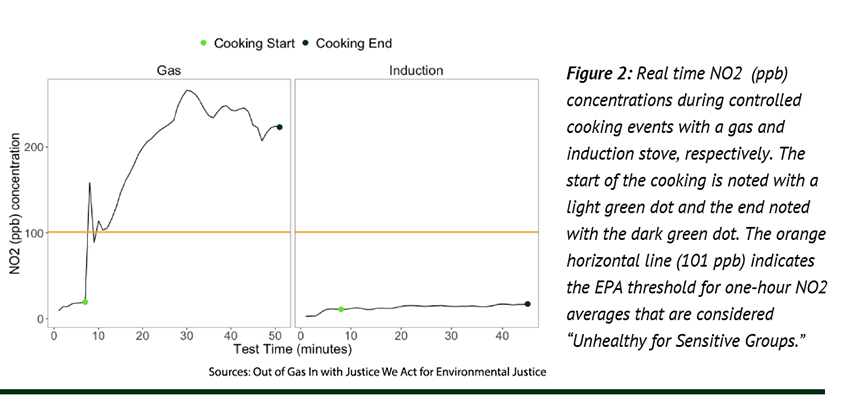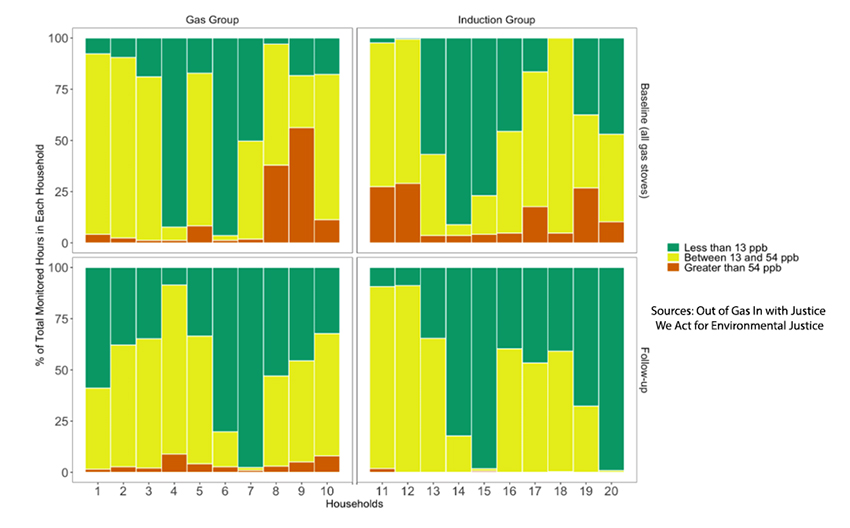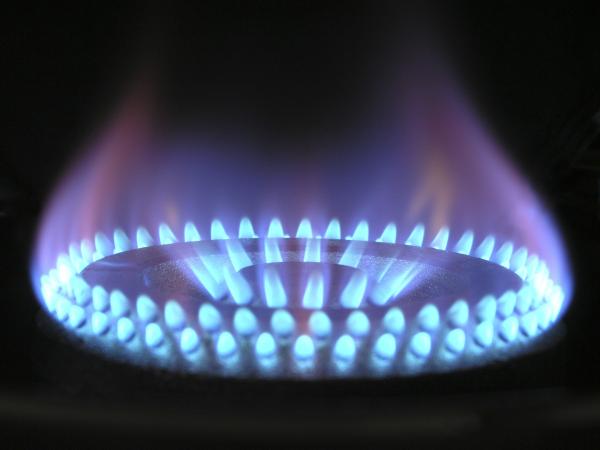The study involved 20 households in a New York City Housing Authority (NYCHA) building slated for electrification from February to July last year. Ten households continued to cook with gas, while the other households were outfitted with new induction ranges. Air quality in the kitchen was measured for one week on three different occasions in all households, and a controlled cooking test was performed in six of those 20 households. [1] Let’s begin with that controlled cooking test. Here is a graphic of the data.

One of the concerns with gas stoves is the production of NO2, an irritant that causes wheezing and may exacerbate asthma. As is to be expected, there is no increase in NO2 from induction cooking, but the levels rise at the stove while cooking with gas. The graphic draws your attention to that EPA threshold – essentially, all the cooking time was spent over that amount. But if one reads the EPA’s report, that threshold comes with caveats. In the range of 100 to 500 ppb on NO2, there was an increasing dose-response resulting in increased airway resistance, the cause of the wheezing and exacerbations of asthma. But these increases in airway resistance were seen only 25% of the time, so population guidelines are not precise. Moreover, individual studies do not show a consistency of the 100ppb threshold. In the EPA’s words, “the interpretation of these results for any specific exposure concentration within the range of 100 to 530 ppb is uncertain.”
Here is the data on overall exposure to NO2. The WHO guidelines suggest that values greater than 13 ppb are detrimental to our health; EPA places that tipping point at 54 ppb.

The top figures were the baseline when all households were using gas stoves. The bottom demonstrates the hours that each home was exposed to NO2. The homes with induction heating showed a remarkable drop in NO2 greater than the EPA cutoffs. But those homes with gas stoves fared pretty well, too, so something not being measured influenced their findings – at best, gas stoves were only partially responsible for NO2 levels.
The research also asked how satisfied participants were with their new induction stoves. They loved them. They were also relieved not to have old gas stoves that had not been adequately maintained or have worries about the odor of gas wafting through their building – two stressors that may be more related to NYCHA housing than gas stoves in general.
There are a few caveats. It is a very small pilot study, and there were difficulties with the air monitoring and cooking trials, so several data points, including most of the data on CO, were lost. The type of cooking and the actual ventilation in the apartments were not characterized, two drivers of ambient NO2. And we are talking about NYCHA housing, where up to 85% of households used their gas stoves to heat their apartment, hours longer than the hour spent cooking a meal.
Costs
The study attempts to show cost savings for participants using induction over gas for cooking. While it costs an additional $6 monthly for electricity for cooking, in homes that “only pay for cooking gas,” i.e., NYCHA homes, the elimination of a monthly minimum service charge for gas would save roughly $11 a month.
There were other costs not considered that we should mention. First, the induction stove retails at about $1200. Second, replacing cookware. Not all cookware works on an induction stove; a new set runs about $250. Of course, as the authors note, “Certain pots and pans that are not induction-ready may also have cultural significance, and households may be reluctant to give them up.”
Next up, an induction stove requires more juice, which requires rewiring. In the case of the study, the NYCHA houses were constructed so that only two apartments along an electrical circuit could use induction stoves; otherwise, it would overload the system. According to New York magazine, retrofitting costs for an apartment COSTS roughly $7500, double that if you have a townhouse. When talking about apartment buildings, the amount of electricity needed mandates the presence of an “electrical room” able to withstand fire for two hours and with two exits, another hurdle for older buildings. Electricity fades with distance, so while the apartments on the lower levels are cooking with volts [[HUH???]], it may take 45 minutes to preheat an electric oven on an upper floor. And the New York article quotes the cost of cooking with electricity as five times that of cooking with gas.
For those advocating cooking with volts, these costs can all be reduced due in part to the federal Inflation Reduction Act. If you earn UP TO 150% of your local community’s median income, you can get an $850 rebate for an induction range – but only for a purchase you make in the future, as the kinks in the rebate system are not worked out. There is also $8,600 available in New York as a tax credit to cover the costs of upgrading the electricity in your home. [2]
I give the authors credit for putting this study forward. They have a bias, but you must be blind not to notice and factor it in evaluating the study. While induction cooking may be beneficial, there are a lot of knowledge gaps to fill.
- If these reductions in NO2 can be shown consistently, do they make a difference in the health of these home dwellers? That is the outcome of real interest.
- Can an old dwelling be retrofitted at a reasonable cost? Who will bear that cost?
- Do we have the infrastructure to support this increase in electrical use? Not just at the supply end, as sunlight, wind, or dare I say, natural gas or nuclear, but in the distribution lines.
[1] “A standardized meal of spaghetti, tomato sauce, steamed broccoli, and chocolate chip cookies was prepared three times in each household….”
[2] A rough calculation puts your income as a married couple at north of $161,550. New York’s median household income is roughly $75,000
Sources: Out of Gas In with Justice We Act for Environmental Justice
Bronx Residents Got Rid of Their Gas Stoves. Their Air Quality Markedly Improved. The City
Good Luck Switching to an Induction Stove in the City New York Magazine




